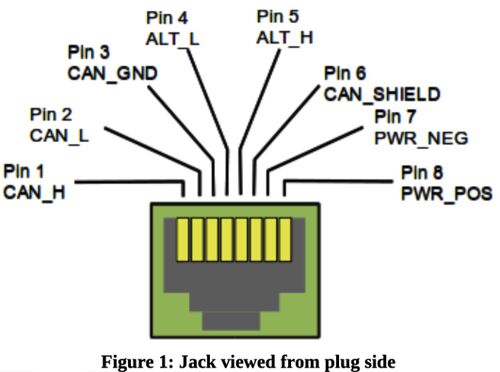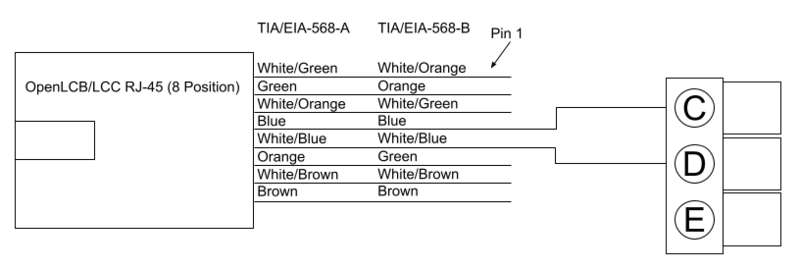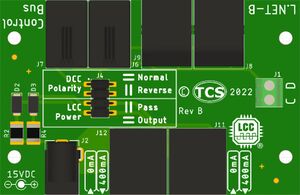Booster Interface: Difference between revisions
No edit summary |
|||
| Line 16: | Line 16: | ||
==Digitrax CS to TCS Booster or TCS CS to Digitrax Booster== | ==Digitrax CS to TCS Booster or TCS CS to Digitrax Booster== | ||
[[File:Booster Interface (LCC to Digitrax).png|800px]] | [[File:Booster Interface (LCC to Digitrax).png|800px]] | ||
<br />'''Important Requirement:''' Most Digitrax boosters are not electrically isolated (sometimes referred to as "opto-isolated"). Unless using an electrically isolated booster | <br />'''Important Requirement:''' Most Digitrax boosters are not electrically isolated (sometimes referred to as "opto-isolated"). Unless using an electrically isolated booster, a booster common must be used. The booster common terminal is typically labeled "GR" on Digitrax boosters and command stations and labeled "Common" on TCS boosters and command stations. For more information, see section [[#Booster Common]] below. | ||
==Lenz CS to TCS Booster or TCS CS to Lenz Booster== | ==Lenz CS to TCS Booster or TCS CS to Lenz Booster== | ||
| Line 26: | Line 26: | ||
<br />'''Note:''' All NCE Boosters are electrically isolated, however, a booster common is still recommended. The booster common is typically found on the metal enclosure screw(s) on NCE boosters and command stations and labeled "Common" on TCS boosters and command stations. For more information, see section [[#Booster Common]] below. | <br />'''Note:''' All NCE Boosters are electrically isolated, however, a booster common is still recommended. The booster common is typically found on the metal enclosure screw(s) on NCE boosters and command stations and labeled "Common" on TCS boosters and command stations. For more information, see section [[#Booster Common]] below. | ||
== Booster Interface Conversion Board == | ==Booster Interface Conversion Board== | ||
TCS is developing a convenient conversion board to aid in mixing OpenLCB/LCC based command stations and boosters that use the NMRA standard Full Scale Power Station Interface, such as those offered by TCS, with other popular manufacturers. This product is still in development. | TCS is developing a convenient conversion board to aid in mixing OpenLCB/LCC based command stations and boosters that use the NMRA standard Full Scale Power Station Interface, such as those offered by TCS, with other popular manufacturers. This product is still in development. | ||
[[File:Booster Breakout Board.jpg|frameless]] | [[File:Booster Breakout Board.jpg|frameless]] | ||
== Configuration Settings == | ==Configuration Settings== | ||
TCS command station and booster products are integrated with RailCom<sup>®</sup>. Most boosters on the market do not support the same RailCom<sup>®</sup> feature set. When using a TCS command station with a booster that does not support RailCom<sup>®</sup> feedback over the Power Station Interface, it is recommended to choose the '''Enabled with no RailCom''' option for the '''System Settings -> Advanced Options -> Drive LCC Boosters''' option. When using a TCS Booster with a command station that does not support RailCom<sup>®</sup>, it is recommended to choose the '''Disabled''' option for the '''Persistent Settings -> Options -> RailCom Cutout''' option. | TCS command station and booster products are integrated with RailCom<sup>®</sup>. Most boosters on the market do not support the same RailCom<sup>®</sup> feature set. When using a TCS command station with a booster that does not support RailCom<sup>®</sup> feedback over the Power Station Interface, it is recommended to choose the '''Enabled with no RailCom''' option for the '''System Settings -> Advanced Options -> Drive LCC Boosters''' option. When using a TCS Booster with a command station that does not support RailCom<sup>®</sup>, it is recommended to choose the '''Disabled''' option for the '''Persistent Settings -> Options -> RailCom Cutout''' option. | ||
== Output Phase == | ==Output Phase== | ||
Every booster has two outputs, one for each rail. If a locomotive creates a short circuit when passing between two booster districts, this is a likely indicator that the two boosters are out of phase of one another. In this case, swap the two rail outputs on one of the boosters to bring them back into phase with one another. | Every booster has two outputs, one for each rail. If a locomotive creates a short circuit when passing between two booster districts, this is a likely indicator that the two boosters are out of phase of one another. In this case, swap the two rail outputs on one of the boosters to bring them back into phase with one another. | ||
| Line 40: | Line 40: | ||
A booster common provides a controlled low impedance return path between boosters which helps with the transition of a locomotive between two booster districts. A booster common should be of heavy AWG wire designed to carry the full current rating of the booster(s), 14AWG or larger is recommended. | A booster common provides a controlled low impedance return path between boosters which helps with the transition of a locomotive between two booster districts. A booster common should be of heavy AWG wire designed to carry the full current rating of the booster(s), 14AWG or larger is recommended. | ||
=== Non-Electrically Isolated Boosters === | ===Non-Electrically Isolated Boosters=== | ||
When using boosters that are not electrically isolated, a booster common is required. Most Digitrax boosters are not electrically isolated. | When using boosters that are not electrically isolated, a booster common is required. Most Digitrax boosters are not electrically isolated. | ||
=== Electrically Isolated Boosters === | ===Electrically Isolated Boosters=== | ||
All TCS boosters provide electrical isolation, as do boosters from Lenz and NCE. Some Digitrax boosters are also electrically isolated an can be identified by the label "Opto equipped". When using boosters that do have electrical isolation, a booster common is technically optional, but still highly recommended for the following benefits: | All TCS boosters provide electrical isolation, as do boosters from Lenz and NCE. Some Digitrax boosters are also electrically isolated an can be identified by the label "Opto equipped". When using boosters that do have electrical isolation, a booster common is technically optional, but still highly recommended for the following benefits: | ||
# Support for locomotives with "split frame" electrical pickup scheme. This is especially common in older steam locomotives where the locomotive would have pickups on one rail and the tender on the other rail. | #Support for locomotives with "split frame" electrical pickup scheme. This is especially common in older steam locomotives where the locomotive would have pickups on one rail and the tender on the other rail. | ||
# Prevent voltage doubling between two boosters that are out of phase with one another. | #Prevent voltage doubling between two boosters that are out of phase with one another. | ||
Some electrically isolated boosters do not offer a booster common. In this case, a common rail can serve a similar purpose. This is achieved by tying together one output phase or rail of each booster. It is important not to mix together booster common and common rail schemes. Only one type of common should be in use on a given installation. | Some electrically isolated boosters do not offer a booster common. In this case, a common rail can serve a similar purpose. This is achieved by tying together one output phase or rail of each booster. It is important not to mix together booster common and common rail schemes. Only one type of common should be in use on a given installation. | ||
== Copyright & Trademarks == | ==Copyright & Trademarks== | ||
Copyright (C) Train Control Systems, Inc 2022. The LCC Jack image above is taken from the OpenLCB CanPhysical standard. The copyright holders are the authors of the OpenLCB CanPhysical standard and the image is subject to the licensing terms found at https://openlcb.org/licensing. LocoNET<sup>®</sup> is a registered trademark of Digitrax, Inc. RailCom<sup>®</sup> is a registered trademark of Lenz Elektronik GmbH. Any unattributed copyrights and trademarks are unintentional and should be brought to the attention of Train Control Systems, Inc for correction. | Copyright (C) Train Control Systems, Inc 2022. The LCC Jack image above is taken from the OpenLCB CanPhysical standard. The copyright holders are the authors of the OpenLCB CanPhysical standard and the image is subject to the licensing terms found at https://openlcb.org/licensing. LocoNET<sup>®</sup> is a registered trademark of Digitrax, Inc. RailCom<sup>®</sup> is a registered trademark of Lenz Elektronik GmbH. Any unattributed copyrights and trademarks are unintentional and should be brought to the attention of Train Control Systems, Inc for correction. | ||
Revision as of 17:47, 25 June 2022
TCS command station and booster products (CS-105, B-106, etc...) use the NMRA Standard S-9.1.2 Power Station Interface Full Scale Interface method. TCS command station and booster products are compatible with other manufacturers' products that use the same Full Scale Interface. This includes, but not limited to, command stations and boosters from:
- Digitrax
- Lenz
- NCE
TCS command station and booster products are not directly compatible with the alternative Driver/Receiver Interface method.
Power Station Interface on TCS Command Stations and Boosters
TCS products use the OpenLCB/LCC NMRA S-9.7.1.1 CAN Physical Layer, which consists of an RJ-45 connector routing the CAN signals, power, and two ALT signals on pins 4 & 5:

TCS utilizes the ALT_L/ALT_H signals on pins 4 & 5 for the Full Scale Power Station Interface. These signals are used when connecting to other manufacturers' command stations and boosters.
Digitrax CS to TCS Booster or TCS CS to Digitrax Booster

Important Requirement: Most Digitrax boosters are not electrically isolated (sometimes referred to as "opto-isolated"). Unless using an electrically isolated booster, a booster common must be used. The booster common terminal is typically labeled "GR" on Digitrax boosters and command stations and labeled "Common" on TCS boosters and command stations. For more information, see section #Booster Common below.
Lenz CS to TCS Booster or TCS CS to Lenz Booster

Note: All Lenz Boosters are electrically isolated, however a booster common is still recommended. The booster common terminal is typically labeled "⊥" on Lenz boosters and command stations and labeled "Common" on TCS boosters and command stations. Some Lenz command stations and boosters do not have a booster common terminal. For more information, see section #Booster Common below.
NCE CS to TCS Booster or TCS CS to Lenz Booster

Note: All NCE Boosters are electrically isolated, however, a booster common is still recommended. The booster common is typically found on the metal enclosure screw(s) on NCE boosters and command stations and labeled "Common" on TCS boosters and command stations. For more information, see section #Booster Common below.
Booster Interface Conversion Board
TCS is developing a convenient conversion board to aid in mixing OpenLCB/LCC based command stations and boosters that use the NMRA standard Full Scale Power Station Interface, such as those offered by TCS, with other popular manufacturers. This product is still in development.
Configuration Settings
TCS command station and booster products are integrated with RailCom®. Most boosters on the market do not support the same RailCom® feature set. When using a TCS command station with a booster that does not support RailCom® feedback over the Power Station Interface, it is recommended to choose the Enabled with no RailCom option for the System Settings -> Advanced Options -> Drive LCC Boosters option. When using a TCS Booster with a command station that does not support RailCom®, it is recommended to choose the Disabled option for the Persistent Settings -> Options -> RailCom Cutout option.
Output Phase
Every booster has two outputs, one for each rail. If a locomotive creates a short circuit when passing between two booster districts, this is a likely indicator that the two boosters are out of phase of one another. In this case, swap the two rail outputs on one of the boosters to bring them back into phase with one another.
Booster Common
A booster common provides a controlled low impedance return path between boosters which helps with the transition of a locomotive between two booster districts. A booster common should be of heavy AWG wire designed to carry the full current rating of the booster(s), 14AWG or larger is recommended.
Non-Electrically Isolated Boosters
When using boosters that are not electrically isolated, a booster common is required. Most Digitrax boosters are not electrically isolated.
Electrically Isolated Boosters
All TCS boosters provide electrical isolation, as do boosters from Lenz and NCE. Some Digitrax boosters are also electrically isolated an can be identified by the label "Opto equipped". When using boosters that do have electrical isolation, a booster common is technically optional, but still highly recommended for the following benefits:
- Support for locomotives with "split frame" electrical pickup scheme. This is especially common in older steam locomotives where the locomotive would have pickups on one rail and the tender on the other rail.
- Prevent voltage doubling between two boosters that are out of phase with one another.
Some electrically isolated boosters do not offer a booster common. In this case, a common rail can serve a similar purpose. This is achieved by tying together one output phase or rail of each booster. It is important not to mix together booster common and common rail schemes. Only one type of common should be in use on a given installation.
Copyright & Trademarks
Copyright (C) Train Control Systems, Inc 2022. The LCC Jack image above is taken from the OpenLCB CanPhysical standard. The copyright holders are the authors of the OpenLCB CanPhysical standard and the image is subject to the licensing terms found at https://openlcb.org/licensing. LocoNET® is a registered trademark of Digitrax, Inc. RailCom® is a registered trademark of Lenz Elektronik GmbH. Any unattributed copyrights and trademarks are unintentional and should be brought to the attention of Train Control Systems, Inc for correction.
